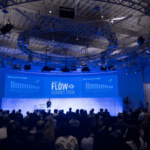Meg Bedford is living a career that repeatedly sees her being in the right place at the right time.
That’s no coincidence.
Listen to Bedford tell her story and you’ll soon realize that she creates the right time by driving some of the world’s best-known brands in the right direction when it counts most. In a serial fashion, she’s been behind bigger and bolder moves in digital commerce by both publishers and ecommerce merchants.
Bedford recently held a rooftop room full of ecommerce professionals and strategists in thrall as she traced a career that so far has spanned Cosmopolitan, Vogue, TOM FORD, Louis Vuitton, Pat McGrath Labs and now TUMI, where she is vice president of marketing and customer experience.
The occasion was FLOW New York, an evening of networking, learning, socializing and celebrating retail successes at a rooftop restaurant appropriately overlooking Macy’s Herald Square (and the Empire State Building for those less-retail obsessed.) It was a night when Lacoste and digital agency Corra were recognized respectively with the FLOW Customer Experience and the FLOW Digital Experience Innovation awards.
It was also a night when, during a nearly one-hour conversation with Signifyd Senior Vice President of Marketing and Alliances Indy Guha, Bedford offered insights on some of retail’s most vexing challenges — breaking down silos, defining customer experience and aligning an entire organization on a business’ approach and goals.
How Meg Bedford traveled from digital marketing to ecommerce leadership
She also liberally sprinkled in career advice in the form of a series of anecdotes that described what had worked for her and what broad conclusions she had drawn about carving a path that led from digital-marketing work in media to ecommerce work in retail.
“People always ask me, ‘How did you switch from digital marketing to ecommerce?’ It’s not necessarily a switch, because everything is really the same,” she said of moving from Vogue and parent Condé Nast to fashion label TOM FORD. “From an acquisition point of view, you’re trying to get traffic to your site every day.”
And you are trying to get that traffic to engage, or covert. To do so, you rely on data, Bedford said, and you use it to drive traffic, engagement and ultimately conversion.
No question, data and digital have never been far from Bedford’s mind. At Vogue, she was on the team that launched Vogue.com. She guided other companies’ digital aspirations for a time while running her own consulting firm.
At TOM FORD, she launched “See-Now, Buy-Now,” six months after Ford announced in the media that he was shaking up fashion’s tradition of showcasing pieces on the runway months before they were actually available for consumers to buy.
In a sense, See-Now, Buy-Now meant launching a business. The initiative required ready-to-wear to be available online and it meant shipping inventory from stores, so consumers could buy the pieces as they came down the runway live.
“We launched omnichannel retail in six months,” Bedford said. “We created one source of inventory and activated all stores in the U.S.” And the line needed to be photographed and merchandised for digital commerce.
So how? How do you do that?
Breaking down silos is the first step in accelerating success
“The first thing you do is get everyone from every cross-functional team,” she said. “You need your retail team. You need your technology team and your development team. You need everyone to really get behind it. You can’t do it alone.”
Breaking down silos. It was the biggest lesson from the sprint, Bedford said. And one she’d deploy more than once in her career.
Ah, Bedford’s career. It was a topic of interest at FLOW, which attracts retail professionals at different stages of their own careers. Most come to commiserate and strategize on common retail challenges. But many also participate, hoping to be inspired and encouraged to take the necessary steps to develop into an elite retail leader.
When it was time for a new opportunity, one audience member wanted to know, how did Bedford know it was time for a new opportunity?
The first step, Bedford explained earlier in the evening, is to always be ready when opportunity arises. Bedford said she constantly networks and talks to others in the industry about where things are headed, who’s innovating how. She’s agreed to job interviews for opportunities she didn’t necessarily believe were the right fit — and then they were.
“It’s like dating,” she joked. “The minute you stop doing it, you become very stale. You have to keep talking to people.”
And in response specifically to the audience member’s question, she offered succinct advice.
“If I felt like I could grow and learn more, and I could contribute in a way that would help the company succeed — those are the things that I really looked at.”
It was also important to consider the people who would be helping you do all those things, Bedford said. She said she looks at how long those working for an organization have been working there. Did it appear to be a group that liked coming to work and shared a passion for getting the job done?
It’s a formula that has worked for Bedford who is now focused on making this the right time for TUMI. As her title suggests, Bedford is responsible for the customer experience that the brand provides. The job is complicated by a diversity of sales channels — online, mobile, in-store, marketplaces, authorized sellers — and a diversity of geographies, including sales in dozens of countries.
Bedford and TUMI tackled the challenge by forming an omnichannel task force. It was not a task force created for appearances only. The group includes representatives from retail, ecommerce, warehousing, logistics, customer service, “all of the channels,” Bedford said.
Ten hours and a list of priorities
The group started by sitting in a room together for 10 hours and creating a list of priorities to put meaning behind the term “customer experience.”
“We all came together at the same time to really talk about policies and procedures and how things worked,” she said. It was a step toward creating a customer experience team that includes experts in ecommerce, marketing, development and data.
The team thinks in terms of the entire customer journey, from awareness to consideration to purchase to loyalty.
“It’s how we organize our entire culture,” Bedford said. It’s all about “how does a customer see things. It’s not about me deciding what we’re going to do from a brand perspective. It’s what does the customer want, right now.”
That perspective changes the conversation, Bedford said, and provides clarity for decisions that potentially could be bogged down by considerations that don’t necessarily benefit customers.
A similar approach keeps TUMI, founded in 1975, on track in an era when longstanding retailers are being disrupted by upstart startups that sell primarily online and seek to provide a distinctive customer experience.
Yes, TUMI pays attention to new competitors, Bedford said. But it works hard not to be distracted by them.
“What we’re trying to do is continue to perfect what we’re good at, which is quality, innovation and function,” Bedford said. “You have to be smart and continue to gain agility when your company has heritage. But I also think there is a difference between a company that started two years ago, three years ago, versus 45 years ago. You have to present 45 years of a heritage, in today’s landscape, and the reality is, that’s what customers want.”
Be smart and continue to gain agility. It sounds a little like what it takes to find yourself in the right place at the right time — again and again.
Photo by Amanda Lee











